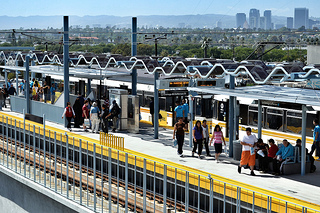Expo Line Spurring Transit-Oriented Development In South L.A., Culver City

Multiple large scale projects are going up adjacent to Expo Line stations. At the 23rd Street station, riders can see the massive wood frame of the Lorenzo under construction on a site that was once a parking lot that nearly covered an entire block. The developer, G.H. Palmer associates, is pouring roughly $250 million into the project. 495 apartments at the Lorenzo will open this summer, with space for 1,990 residents, primarily USC students, says Meshay Talae, the Lorenzo’s marketing manager.
The second phase of the building is still under construction. When completed in 2014, it will have 913 apartments, with a maximum occupancy of 3,700 people. Phase two will also include retail space along Flower Street, “All of the shops will be by the 23rd Street stop” Talae said, “We expect local people and residents to use the Metro and shop at our stores.”
In August, a building called Icon Plaza opened at the corner of Figueroa Street and Exposition Boulevard, right between the Expo Park and Jefferson stations. The 56-unit building now houses 250 USC students, and has a first floor occupied by eateries.
Just one block down Crenshaw Boulevard from the Expo/Crenshaw station, a $93 million shopping center to be called District Square will replace a Ralph’s grocery store and its sprawling parking lot. According to the project website, it will include two stories of shops, including a Target.
The landscape along the western section of the line consists mostly of 1-story houses, drive-throughs, and strip malls. Farther along, the route passes through industrial areas made up of single-story, often windowless buildings that many would call ugly.
But the neighborhood’s character is beginning to change. The Expo Line’s current terminus in Culver City has become another magnet for development. One current project, Legado Crossing, will consist of 115 apartments, with a commercial space on the ground floor.
Joseph Miller is the president of the Runyon Group, which has plans for a large commercial building by the Culver City station, on the current site of an old car dealership. Miller says that the building, which has been named Platform in reference to the nearby station, will house offices and boutiques and will have a height varying between 1 and 5 stories. He expects construction to start in about two months, to be completed in Spring of 2015.
Miller also said that standard parking requirements are in place for Platform, even though it is located next to a transit station. Many activists believe that requiring the same amount of parking regardless of transit access does not make sense. An LA Times editorial argues that reducing parking requirements in areas with good public transit have worked before to spur development, “When parking rules were eased for developers who converted office buildings downtown into residential projects, it started a housing renaissance that helped turn a fading commercial center into a booming urban community.”
These projects, combined with the boom in residential construction in Downtown LA, particularly in the South Park area, will place thousands of new residents, shoppers, and workers along the Expo Line corridor over the next few years.
Notably, these projects are happening without extra support from municipal governments. Todd Tipton of the Culver City Community Development Department says that no financial incentives were offered to the developers of Legado Crossing and Platform.
Unfortunately, there are also signs that with the increasing desireability of neighborhoods along the line, some low-income residents are being priced out.
Metro is heavily involved in transit oriented development, owning 16 developments close to Metro Rail stations, according to the LA Times. However, Metro did not take an active role in any of the projects described above. The exception, however, is one still-in-the-works development on the site of what is now the Culver City station parking lot. Tipton said, "The City hopes to construct a mixed used (commercial/residential/hotel) project on the site in the coming years. The project details are currently being negotiated with Lowe Enterprises."
Still, an abundance of room remains for further development. A study of development opportunities by the Center for Transit Oriented Development identified hundreds of developable properties along the Expo Line. This includes 80 acres of underutilized land near the Jefferson/USC station, 104 acres near the Culver City station and 89 acres near the La Cienega/Jefferson station.
According to the Center for Transit Oriented Development, "Transit-oriented development, is a type of community development that includes a mixture of housing, office, retail and/or other commercial development and amenities integrated into a walkable neighborhood and located within a half-mile of quality public transportation." Such development is encouraged for its health, economic, and environmental benefits. The fact that the Expo Line has succeeded in encouraging so many transit oriented development projects is a promising sign for the years to come.
Read more of Neon Tommy's transportation coverage, click here.
Reach Staff Reporter Axel Hellman here.



